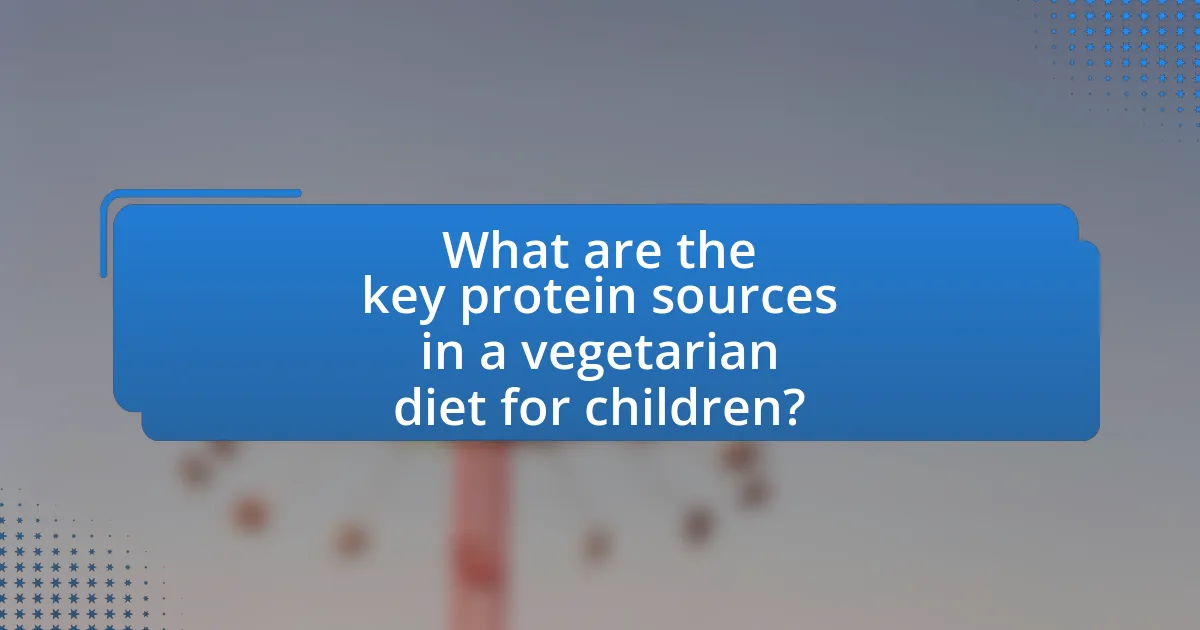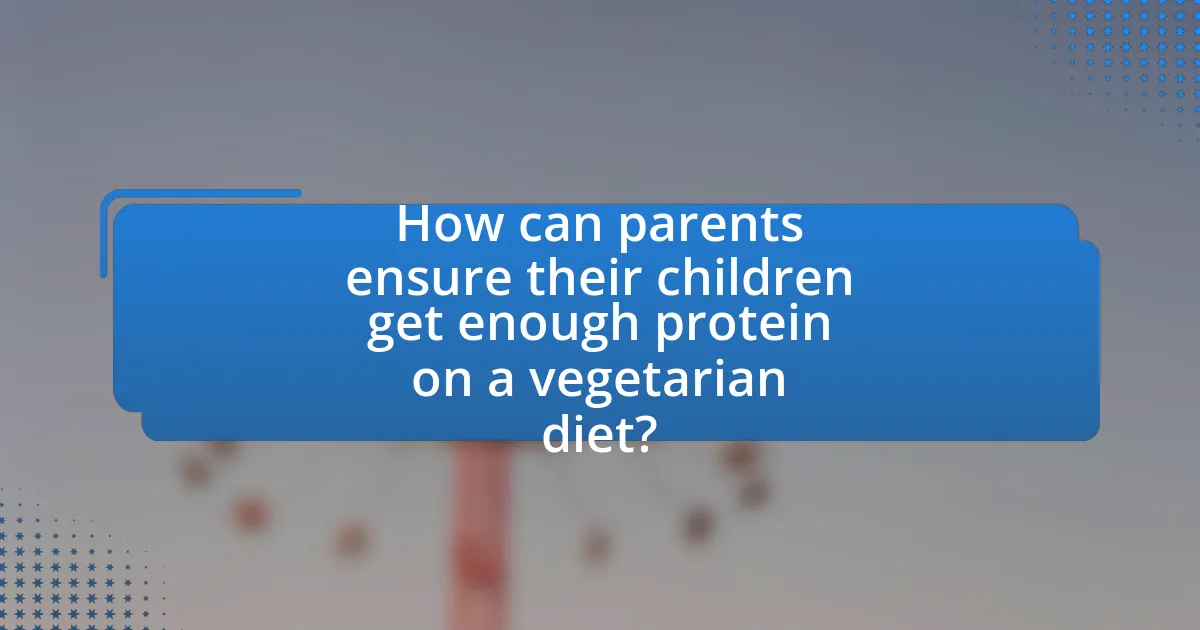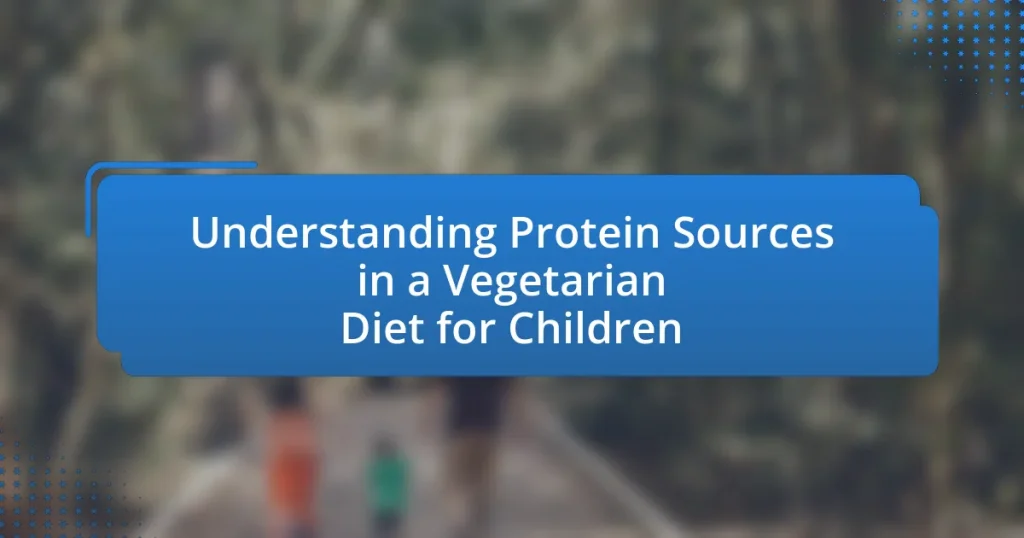The article focuses on understanding protein sources in a vegetarian diet for children, highlighting key protein-rich foods such as legumes, nuts, seeds, dairy products, and whole grains. It compares plant-based proteins to animal proteins, discussing their nutritional benefits and the importance of essential amino acids. The article also addresses how children can meet their protein needs through various vegetarian sources, the role of legumes and grains, and strategies for combining protein sources effectively. Additionally, it outlines potential nutritional deficiencies, practical tips for parents, and the significance of monitoring protein intake to support children’s growth and development.

What are the key protein sources in a vegetarian diet for children?
Key protein sources in a vegetarian diet for children include legumes, nuts, seeds, dairy products, and whole grains. Legumes such as lentils, chickpeas, and beans provide essential amino acids and are rich in protein, with lentils containing about 18 grams of protein per cooked cup. Nuts and seeds, including almonds and chia seeds, offer healthy fats and protein, with almonds providing approximately 6 grams of protein per ounce. Dairy products like yogurt and cheese are also significant sources, with Greek yogurt containing around 20 grams of protein per cup. Whole grains such as quinoa and brown rice contribute additional protein, with quinoa providing about 8 grams of protein per cooked cup. These sources collectively ensure that children receive adequate protein for growth and development in a vegetarian diet.
How do plant-based proteins compare to animal proteins?
Plant-based proteins generally contain less protein per serving compared to animal proteins but offer additional health benefits. For instance, animal proteins, such as meat and dairy, provide complete proteins with all essential amino acids, while many plant-based proteins, like beans and lentils, may lack one or more essential amino acids. However, plant-based proteins are often lower in saturated fat and cholesterol, contributing to better heart health. Research published in the Journal of the American College of Cardiology indicates that diets high in plant-based proteins are associated with a lower risk of cardiovascular disease. Therefore, while animal proteins are more concentrated sources of protein, plant-based proteins provide a healthier alternative with additional nutritional benefits.
What are the essential amino acids found in plant proteins?
The essential amino acids found in plant proteins include histidine, isoleucine, leucine, lysine, methionine, phenylalanine, threonine, tryptophan, and valine. These amino acids are crucial for various bodily functions, including growth and repair of tissues. Research indicates that while many plant proteins may lack one or more of these essential amino acids, combining different plant sources, such as legumes and grains, can provide a complete amino acid profile necessary for a balanced diet, particularly important in vegetarian diets for children.
How can children meet their protein needs through vegetarian sources?
Children can meet their protein needs through vegetarian sources by consuming a variety of plant-based foods rich in protein. Legumes such as lentils, chickpeas, and beans provide substantial protein content; for example, one cup of cooked lentils contains about 18 grams of protein. Additionally, whole grains like quinoa and brown rice, as well as nuts and seeds, contribute to protein intake; quinoa offers approximately 8 grams of protein per cooked cup. Dairy products and eggs, if included in a vegetarian diet, also serve as excellent protein sources, with one large egg containing about 6 grams of protein. Combining different protein sources, such as rice and beans, enhances the overall protein quality, ensuring children receive all essential amino acids necessary for growth and development.
What types of vegetarian protein sources are available?
Vegetarian protein sources include legumes, nuts, seeds, whole grains, dairy products, and plant-based meat alternatives. Legumes such as lentils, chickpeas, and black beans are rich in protein and fiber, providing essential nutrients for growth. Nuts and seeds, including almonds, chia seeds, and hemp seeds, offer healthy fats along with protein. Whole grains like quinoa and brown rice contribute both carbohydrates and protein, making them a staple in vegetarian diets. Dairy products, such as yogurt and cheese, are also significant sources of protein for those who consume them. Additionally, plant-based meat alternatives, often made from soy or pea protein, provide a meat-like texture and protein content, catering to vegetarian preferences. These sources collectively ensure that children following a vegetarian diet can meet their protein needs effectively.
What role do legumes play in a vegetarian diet?
Legumes serve as a crucial source of protein in a vegetarian diet, particularly for children who require adequate protein for growth and development. They provide essential amino acids, fiber, vitamins, and minerals, making them a well-rounded food choice. For instance, legumes such as lentils, chickpeas, and beans contain approximately 15-25 grams of protein per cooked cup, contributing significantly to daily protein intake. Additionally, legumes are low in fat and high in complex carbohydrates, which support sustained energy levels in children. Their nutritional profile helps meet dietary needs while promoting overall health.
How can grains contribute to protein intake?
Grains can significantly contribute to protein intake by providing essential amino acids and serving as a staple food source in a vegetarian diet. For instance, whole grains like quinoa, brown rice, and oats contain varying amounts of protein, with quinoa offering about 8 grams of protein per cooked cup. Additionally, grains often complement other protein sources, such as legumes, to create complete protein profiles. Research indicates that combining grains with legumes can enhance the overall protein quality, making it suitable for children following a vegetarian diet.
What are the benefits of incorporating nuts and seeds?
Incorporating nuts and seeds into a vegetarian diet for children provides essential nutrients that support growth and development. Nuts and seeds are rich in protein, healthy fats, vitamins, and minerals, which are crucial for children’s overall health. For instance, almonds contain vitamin E, which is important for immune function, while chia seeds are high in omega-3 fatty acids, promoting brain health. Additionally, a study published in the Journal of Nutrition found that children who consume nuts regularly have a lower risk of developing obesity and related health issues, highlighting the importance of these foods in a balanced diet.
Why is protein important for children’s growth and development?
Protein is crucial for children’s growth and development because it supports the formation of muscles, tissues, and organs. Adequate protein intake is essential for the production of enzymes and hormones, which regulate various bodily functions. Research indicates that children require protein for proper growth; for instance, the Recommended Dietary Allowance (RDA) for protein in children aged 1-3 years is 13 grams per day, while children aged 4-8 years need 19 grams per day. Insufficient protein can lead to stunted growth and developmental delays, highlighting its importance in a balanced diet, especially in vegetarian diets where protein sources must be carefully selected to meet these needs.
How does protein support muscle development in children?
Protein supports muscle development in children by providing essential amino acids necessary for muscle growth and repair. During periods of growth and physical activity, children require adequate protein intake to facilitate the synthesis of new muscle tissue. Research indicates that protein consumption can enhance muscle mass and strength in children, particularly when combined with physical exercise. For instance, a study published in the American Journal of Clinical Nutrition found that children who consumed sufficient protein showed improved muscle development compared to those with inadequate protein intake. This underscores the critical role of protein in supporting the physiological demands of growing children.
What impact does protein have on cognitive function?
Protein plays a crucial role in cognitive function by supporting neurotransmitter synthesis and brain structure. Adequate protein intake is essential for the production of neurotransmitters such as dopamine and serotonin, which are vital for mood regulation and cognitive processes. Research indicates that children with sufficient protein in their diets demonstrate improved attention, memory, and overall cognitive performance. For instance, a study published in the journal “Nutrients” found that protein deficiency can lead to impaired cognitive development in children, highlighting the importance of protein-rich foods in a vegetarian diet for optimal brain health.

How can parents ensure their children get enough protein on a vegetarian diet?
Parents can ensure their children get enough protein on a vegetarian diet by incorporating a variety of protein-rich plant foods such as legumes, nuts, seeds, whole grains, and dairy products if not vegan. Legumes like lentils and chickpeas provide substantial protein; for instance, one cup of cooked lentils contains about 18 grams of protein. Nuts and seeds, such as almonds and chia seeds, also contribute significantly, with two tablespoons of chia seeds offering around 4 grams of protein. Whole grains like quinoa and brown rice can complement protein intake, as quinoa contains about 8 grams of protein per cooked cup. Additionally, dairy products like yogurt and cheese can be included for those who consume them, with Greek yogurt providing approximately 10 grams of protein per 100 grams. By combining these sources throughout the day, parents can effectively meet their children’s protein needs on a vegetarian diet.
What strategies can be used to combine protein sources effectively?
Combining protein sources effectively involves pairing complementary proteins to ensure a complete amino acid profile. For example, combining legumes, such as beans or lentils, with grains like rice or quinoa provides all essential amino acids necessary for growth and development in children. Research indicates that this strategy enhances protein quality, as legumes are typically low in methionine while grains are low in lysine, thus together they create a balanced protein source. Additionally, incorporating dairy or soy products with plant-based proteins can further optimize amino acid intake, supporting overall nutritional needs in a vegetarian diet for children.
How can parents create balanced meals that include protein?
Parents can create balanced meals that include protein by incorporating a variety of plant-based protein sources such as legumes, nuts, seeds, and whole grains. For instance, combining lentils with brown rice provides a complete amino acid profile, essential for children’s growth and development. Research indicates that legumes, such as chickpeas and black beans, are not only rich in protein but also high in fiber, which supports digestive health. Additionally, including nuts like almonds or walnuts in meals or snacks can enhance protein intake while providing healthy fats. By ensuring meals contain a mix of these protein sources, parents can effectively meet their children’s nutritional needs in a vegetarian diet.
What are some easy vegetarian recipes rich in protein?
Easy vegetarian recipes rich in protein include lentil soup, chickpea salad, and quinoa stir-fry. Lentil soup provides approximately 18 grams of protein per cooked cup, making it a hearty option. Chickpea salad, made with canned chickpeas, offers around 15 grams of protein per cup and can be enhanced with vegetables and dressing. Quinoa stir-fry, using one cup of cooked quinoa, delivers about 8 grams of protein and can be mixed with various vegetables and tofu for added protein. These recipes are not only simple to prepare but also ensure adequate protein intake for children following a vegetarian diet.
What are common misconceptions about protein in vegetarian diets?
Common misconceptions about protein in vegetarian diets include the belief that vegetarian diets lack sufficient protein and that plant-based proteins are inferior to animal-based proteins. In reality, many vegetarian foods, such as legumes, nuts, seeds, and whole grains, provide ample protein. For instance, lentils contain about 18 grams of protein per cooked cup, while quinoa offers all nine essential amino acids, making it a complete protein source. Additionally, research published in the Journal of the American Dietetic Association indicates that well-planned vegetarian diets can meet protein needs effectively, debunking the myth that vegetarians cannot obtain adequate protein.
Why do some believe vegetarian diets lack sufficient protein?
Some believe vegetarian diets lack sufficient protein due to the perception that plant-based protein sources do not provide all essential amino acids. This belief stems from the fact that many plant proteins are considered “incomplete,” meaning they lack one or more essential amino acids that the body cannot synthesize. For instance, grains and legumes, common staples in vegetarian diets, often do not contain sufficient levels of certain amino acids like lysine or methionine. Additionally, the average protein intake from vegetarian sources may be lower than that from animal sources, which are complete proteins. Research indicates that while it is possible to obtain adequate protein from a well-planned vegetarian diet, misconceptions persist, leading to concerns about protein sufficiency among those unfamiliar with diverse plant-based options.
How can parents address concerns about protein intake?
Parents can address concerns about protein intake by incorporating a variety of plant-based protein sources into their children’s diets. Foods such as lentils, chickpeas, quinoa, tofu, and nuts provide essential amino acids necessary for growth and development. Research indicates that a well-planned vegetarian diet can meet protein needs; for example, the American Dietetic Association states that vegetarian diets can provide adequate protein for children when diverse sources are included. By ensuring meals contain a mix of these protein-rich foods, parents can effectively support their children’s nutritional requirements.

What are the potential challenges of a vegetarian diet for children?
A vegetarian diet for children can present challenges such as inadequate protein intake, potential nutrient deficiencies, and difficulties in meal planning. Children require sufficient protein for growth and development, and vegetarian sources may not provide all essential amino acids unless carefully combined. Research indicates that vegetarian diets can lead to deficiencies in nutrients like iron, vitamin B12, and omega-3 fatty acids, which are crucial for cognitive and physical development. For instance, a study published in the Journal of the American Dietetic Association highlights that vegetarian children may have lower iron stores compared to their omnivorous peers, emphasizing the need for careful dietary planning to ensure all nutritional needs are met.
What nutritional deficiencies should parents be aware of?
Parents should be aware of potential nutritional deficiencies in iron, vitamin B12, calcium, and omega-3 fatty acids when raising children on a vegetarian diet. Iron deficiency can lead to anemia, particularly in children who do not consume sufficient plant-based sources like lentils and fortified cereals. Vitamin B12, primarily found in animal products, is crucial for neurological function and blood formation; its deficiency can result in developmental delays. Calcium is essential for bone health, and vegetarian sources such as fortified plant milks and leafy greens may not provide adequate amounts without careful planning. Omega-3 fatty acids, important for brain development, are less abundant in vegetarian diets, necessitating attention to sources like flaxseeds and walnuts.
How can parents prevent iron deficiency in vegetarian children?
Parents can prevent iron deficiency in vegetarian children by ensuring they consume iron-rich plant foods and pairing them with vitamin C sources to enhance absorption. Foods such as lentils, chickpeas, beans, tofu, quinoa, fortified cereals, and dark leafy greens are excellent sources of non-heme iron. Additionally, incorporating fruits and vegetables high in vitamin C, like oranges, strawberries, and bell peppers, can significantly improve iron absorption from these plant sources. Research indicates that vegetarian diets can meet iron needs if properly planned, as outlined in the American Dietetic Association’s position paper on vegetarian diets, which emphasizes the importance of combining iron-rich foods with vitamin C for optimal absorption.
What role does vitamin B12 play in a vegetarian diet?
Vitamin B12 is essential in a vegetarian diet as it supports nerve function, red blood cell formation, and DNA synthesis. Vegetarians often lack sufficient B12 because it is primarily found in animal products. According to the National Institutes of Health, a deficiency in vitamin B12 can lead to anemia and neurological issues, making it crucial for vegetarians, especially children, to obtain this vitamin through fortified foods or supplements.
How can parents monitor their child’s protein intake effectively?
Parents can effectively monitor their child’s protein intake by tracking daily food consumption and ensuring a balanced diet that includes various protein sources. Utilizing food diaries or mobile apps can help parents log meals and snacks, making it easier to calculate protein intake from vegetarian sources such as legumes, nuts, seeds, dairy, and whole grains. Research indicates that children aged 1-3 require about 13 grams of protein daily, while those aged 4-8 need around 19 grams, highlighting the importance of meeting these nutritional needs through careful meal planning and monitoring.
What tools or resources are available for tracking nutrition?
Various tools and resources are available for tracking nutrition, including mobile applications, websites, and wearable devices. Popular mobile apps like MyFitnessPal and Cronometer allow users to log food intake, track macronutrients, and analyze dietary patterns. Websites such as USDA’s FoodData Central provide comprehensive databases of food nutrition information, while wearable devices like Fitbit can monitor daily activity and caloric expenditure, aiding in overall nutrition tracking. These resources are widely used for their accuracy and user-friendly interfaces, making them effective for individuals seeking to manage their dietary habits.
How can parents assess if their child is meeting protein needs?
Parents can assess if their child is meeting protein needs by monitoring their growth, development, and dietary intake. Regular check-ups with a pediatrician can provide insights into growth patterns, while keeping a food diary can help track protein-rich foods consumed. The Recommended Dietary Allowance (RDA) for protein varies by age; for example, children aged 1-3 years require about 13 grams of protein daily, while those aged 4-8 years need around 19 grams. Parents can evaluate their child’s protein intake against these guidelines, ensuring they include diverse vegetarian sources such as legumes, nuts, seeds, and dairy products. Additionally, signs of protein deficiency, such as fatigue, poor growth, or weakened immunity, can indicate inadequate protein consumption.
What practical tips can help parents support their vegetarian children’s protein needs?
To support their vegetarian children’s protein needs, parents should incorporate a variety of protein-rich plant foods into their diets. These foods include legumes such as lentils, chickpeas, and beans, which provide essential amino acids. Additionally, parents can include whole grains like quinoa and brown rice, as well as nuts and seeds, which are also good sources of protein.
Research indicates that combining different plant protein sources, such as rice and beans, can create a complete protein profile, ensuring children receive all necessary amino acids. The American Dietetic Association states that well-planned vegetarian diets can meet the nutritional needs of children, including protein requirements.


